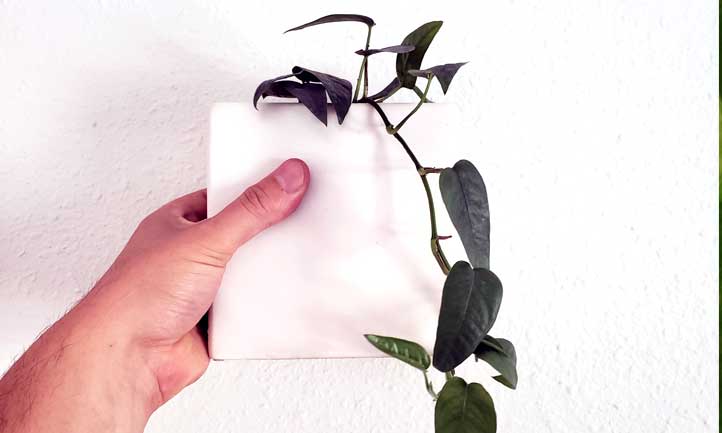9 Types of Pothos to Add To Your Plant Collection
Pothos is one of the first houseplants that many plant novices start out with, and for good reason. It’s easy to care for and highly versatile, as you can:
- Grow in hanging pots and it will cascade downward
- Grow it up a plant totem or moss pole
- Grow it horizontally on table tops, mantles, or windowsills
You can grow it in low light, but it will truly thrive in brighter indoor spaces. It also does not require a lot of water— you just have to ensure that the potting soil gets moist, not dripping wet.
The best bit is that there are so many unique varieties available, so you can grow your very own pothos jungle full of colorful variegation and trailing beauty.
Golden Pothos

You can easily find golden pothos at your local garden center or nursery, since they’re the most common of all pothos plant types. They’re easily identifiable as they have telltale heart-shaped green leaves that are splashed with golden hues.
Also known as Devil’s Ivy, they’re quite resilient and probably the easiest to grow of all of the pothos varieties out there.
Marble Queen Pothos

Marble queen is another common variety of pothos out there, and has a ‘cheesecake’ type of look to it. The white and dark green are interwoven together kind of like a tapestry or knit blanket, forming a gorgeous variegation.
They are a highly variegated variety, and as a result will grow slower as there is less chlorophyll in each leaf. You may want to move them closer to a light source or windowsill to spur their growth.
Neon Pothos

Neon pothos is a unique type of pothos. The heart-shaped leaves a bright, lime green color! The younger, budding leaves have brighter hues, while the older, mature ones have a deep tinge of neon to them.
If you want your Neon pothos to have that signature striking neon color, then grow them under bright light. In low or dim light, the leaves tend to remain dull and dark.
Jessenia Pothos

Jessenia pothos have green heart-shaped foliage spiked with greenish-yellow hues. Every leaf of Jessenia pothos will turn out different than the rest, just like Marble Queen. Jessenia also tends to grow much slower than non-variegated pothos due to lack of chlorophyll.
You’ll be able to easily differentiate between Marble Queen and Jessenia as the limey-green variegation of Jessenia is much darker than the lighter, whiter variegation of Marble Queen.
Manjula Pothos

Manjula Pothos is actually a patented variety of pothos, which was originally produced by the University of Florida. The key differentiator between Manjula and other types of pothos is that the heart shaped leaves of Manjula pothos have curvy edges that refuse to lay flat.
Also, the leaves are variegated with hues of cream, silver, white, and green. As with other pothos types, your Manjula pothos leaves will also differ from each other; some will have large green patches and others will be heavily freckled and painted with the other hues.
Plus, the variegation of Manjula leaves is not clear cut, so you can expect specks of green on the whiter areas.
Pearls and Jade Pothos

This is also a patented type of Pothos and was produced by the University of Florida. Pearls and Jade Pothos has green leaves that are variegated with silver-gray and white hues. You can spot it out amidst an assortment of pothos types by looking for their variegation patterns.
The variegation on their leaves appears on the edges rather than the center. Plus, the whiter portions of the foliage are usually clouded with green and silver-gray shades. Pearls and Jade Pothos have relatively smaller leaves than other varieties and they tend to grow slower too.
Silver / Satin Pothos

This variety of pothos sports gorgeous dark green, heart shaped foliage. The dark green of the leaves is speckled with silver. This type of pothos is also known as Satin Pothos or Silver Pothos. The foliage of Silver Pothos is smaller than other types.
The vine like quality and the sparkling look of the leaves makes it a fantastic addition to your indoor jungle. Just place it in a hanging pot and let the leaves go where their hearts desire. For the brightest shades of silver, make sure you keep it in bright yet indirect light.
N-Joy Pothos

This is one of the newer types of pothos available on the market. It also has variegated green leaves that are heavily dappled with white, and the variegation is largely distinct. You can make the white variegation grow and spread on the foliage if you keep N-Joy Pothos under bright light.
Pothos N-Joy will be as easy to grow for you as any other type of pothos. Just keep it near a light source in your home and see the vine thrive! However, be patient with it since it grows slowly.
Cebu Blue Pothos

This is a special variety of pothos and is the closest to my heart. If you are wondering why, well, it does not sport the signature heart shaped foliage of pothos. Instead, Cebu Blue Pothos have arrow shaped blue-green leaves. Also, usually these leaves have a slight bluish-metallic gleam to them that makes it unique from other types
The younger leaves are usually vaguely shaped like arrows, but if you give Cebu Blue Pothos enough brightness, then the leaves will enlarge and form natural splits! However, they do require time to mature, so you’ll have to be patient.
The Green Thumbs Behind This Article:






